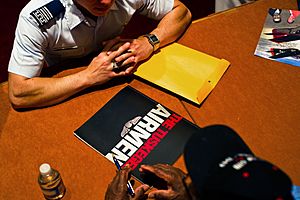Buford A. Johnson facts for kids
Quick facts for kids
Buford A. Johnson
|
|
|---|---|
| Born | August 30, 1927 Longview, Texas, US
|
| Died | April 15, 2017 (aged 89) |
| Occupation | Military airplane mechanic |
| Known for | Tuskegee Airmen |
Master Sergeant Buford A. Johnson (August 30, 1927 – April 15, 2017) was a famous member of the Tuskegee Airmen. This group included brave African-American pilots and the people who supported them during World War II. Buford Johnson was the main mechanic for the fighter planes of the 99th Fighter Squadron. This squadron was part of the 477th Composite Group.
In May 1949, Johnson was the aircraft crew chief for a three-pilot team. This team was from the 332nd Fighter Group Weapons. They won the very first "Top Gun" team competition held by the U.S. Air Force. This big event took place at Las Vegas Air Force Base, which is now called Nellis Air Force Base.
Contents
Buford Johnson's Life Story
Growing Up
Buford A. Johnson was born in Longview, Texas on August 30, 1927. He grew up in Shiloh, Texas. He finished Shiloh High School in 1945.
Joining the Military
When Buford Johnson was 18, the U.S. military called him to join the Navy. Back then, African-American men in the Navy could only do certain jobs. Buford was not interested in these jobs. He learned that if he volunteered for three years in the U.S. Army, it would cancel his Navy draft orders. So, in 1945, Johnson joined the U.S. Army Air Forces. He became one of the first African-Americans allowed to work on U.S. fighter planes.
Johnson did his basic training in Sheppard Field, Texas. After training, he was sent to the 99th Fighter Squadron. This squadron was part of the 477th Composite Group at Godman Field, Kentucky.
After World War II, Johnson was stationed at Lockbourne AFB in Ohio. From there, he moved to Itazuke Air Base in Japan. At Itazuke, his job was to support a P-51 Mustang fighter squadron. Because of his great skills, he became a mechanic for the 80th Fighter-Bomber Squadron's first F-80C Shooting Star jet aircraft. He was the first African-American to be a jet mechanic in the United States Air Force. He was also the first crew chief to work on jet aircraft, and the first to do so in a combat zone.
Johnson left the Korean War zone on December 19, 1951. A month later, in January 1952, he was assigned to the 6520th Test Support Wing. This was at Hanscom AFB in Bedford, Massachusetts. He worked there as an Aircraft Maintenance Supervisor. On April 1, 1953, he was promoted from Technical Sergeant to Master Sergeant.
On July 25, 1956, Johnson was ordered to transfer to the 50th Fighter-Bomber Wing. This base was in Toul-Rosieres Air Base in France. He arrived there three weeks later, on August 15, 1956. He was assigned to the 417th Fighter Group. On July 29, 1960, Johnson moved to the Air Force Test Center at Edwards Air Force Base, California. While working with the 417th Tactical Fighter Squadron at Edwards Air Force Base, Buford received the Air Force Commendation Medal on December 21, 1962. This award was for his excellent service.
He stayed at Edwards Air Force Base until July 1965. Then, he was ordered to transfer to Oxnard Air Force Base, California. There, he became the Non-Commissioned Officer in Charge of Maintenance Control.
Johnson retired from the military in 1966.
Winning the "Top Gun" Competition in 1949
In January 1949, the head of the U.S. Air Force asked all Air Force groups to join an aerial weapons competition. Four months later, in May 1949, Buford Johnson was the crew chief for the 332nd Fighter Group Weapons team. This three-pilot team won the very first "Top Gun" competition held by the U.S. Air Force. The event took place at Las Vegas Air Force Base (now Nellis Air Force Base).
This competition was very tough and lasted 10 days. It included six events:
- Shooting from the air at 20,000 feet
- Shooting from the air at 12,000 feet
- Dive bombing
- Skip bombing
- Rocket firing
- Strafing (shooting at targets on the ground)
The all-African American team was in the lead from the very beginning to the end.
The pilot team included:
- Captain Alva Temple (September 5, 1917 – August 28, 2004) from the 300th Squadron
- First Lieutenant Harry Stewart, Jr. from the 100th Squadron
- James H. Harvey from the 99th Squadron
- First Lieutenant Halbert Alexander (June 12, 1922 – March 25, 1953) from the 99th Squadron, who was an alternate pilot.
Harvey and his team flew P-47N (later called F-47N) Thunderbolts.
The results of this competition and the 3-foot tall silver winning trophy were hidden for 55 years. They were kept in a storage area at the Wright Patterson Air Force Base Museum. The results were not found in the U.S. Air Force records until 1995. The team flew F-47Ns, which were an improved version of the famous Republic P-47 Thunderbolt from World War II. They won against other U.S. Air Force fighter teams that had much more advanced planes like the F-51 and F-82 Twin Mustang. Johnson's teammate, James H. Harvey, said: "They knew who won, but did not want to recognize us."
His Passing
Master Sergeant Buford A. Johnson passed away on April 15, 2017. He was buried in Riverside National Cemetery in Riverside, California.
Awards and Honors
Individual Awards
- U.S. Air Force Medal for Meritorious Service
- A special letter of appreciation from Christina Poulos, Director of the Department of Homeland Security California Service Center.
Group Award
The Tuskegee Airmen, as a group, received the Congressional Gold Medal on April 11, 2006. This was to honor their service to their country. The original medal was given to the Smithsonian Institution. Each individual member received a copy of the medal.


